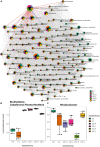Burkholderiaceae Are Key Acetate Assimilators During Complete Denitrification in Acidic Cryoturbated Peat Circles of the Arctic Tundra
- PMID: 33613495
- PMCID: PMC7892595
- DOI: 10.3389/fmicb.2021.628269
Burkholderiaceae Are Key Acetate Assimilators During Complete Denitrification in Acidic Cryoturbated Peat Circles of the Arctic Tundra
Abstract
Cryoturbated peat circles (pH 4) in the Eastern European Tundra harbor up to 2 mM pore water nitrate and emit the greenhouse gas N2O like heavily fertilized agricultural soils in temperate regions. The main process yielding N2O under oxygen limited conditions is denitrification, which is the sequential reduction of nitrate/nitrite to N2O and/or N2. N2O reduction to N2 is impaired by pH < 6 in classical model denitrifiers and many environments. Key microbes of peat circles are important but largely unknown catalysts for C- and N-cycling associated N2O fluxes. Thus, we hypothesized that the peat circle community includes hitherto unknown taxa and is essentially unable to efficiently perform complete denitrification, i.e., reduce N2O, due to a low in situ pH. 16S rRNA analysis indicated a diverse active community primarily composed of the bacterial class-level taxa Alphaproteobacteria, Acidimicrobiia, Acidobacteria, Verrucomicrobiae, and Bacteroidia, as well as archaeal Nitrososphaeria. Euryarchaeota were not detected. 13C2- and 12C2-acetate supplemented anoxic microcosms with endogenous nitrate and acetylene at an in situ near pH of 4 were used to assess acetate dependent carbon flow, denitrification and N2O production. Initial nitrate and acetate were consumed within 6 and 11 days, respectively, and primarily converted to CO2 and N2, suggesting complete acetate fueled denitrification at acidic pH. Stable isotope probing coupled to 16S rRNA analysis via Illumina MiSeq amplicon sequencing identified acetate consuming key players of the family Burkholderiaceae during complete denitrification correlating with Rhodanobacter spp. The archaeal community consisted primarily of ammonia-oxidizing Archaea of Nitrososphaeraceae, and was stable during the incubation. The collective data indicate that peat circles (i) host acid-tolerant denitrifiers capable of complete denitrification at pH 4-5.5, (ii) other parameters like carbon availability rather than pH are possible reasons for high N2O emissions in situ, and (iii) Burkholderiaceae are responsive key acetate assimilators co-occurring with Rhodanobacter sp. during denitrification, suggesting both organisms being associated with acid-tolerant denitrification in peat circles.
Keywords: 16S rRNA stable isotope probing; climatechange; isotope tracing; nitrous oxide; permafrost affected soils.
Copyright © 2021 Hetz and Horn.
Conflict of interest statement
The authors declare that the research was conducted in the absence of any commercial or financial relationships that could be construed as a potential conflict of interest.
Figures





Similar articles
-
Contrasting denitrifier communities relate to contrasting N2O emission patterns from acidic peat soils in arctic tundra.ISME J. 2012 May;6(5):1058-77. doi: 10.1038/ismej.2011.172. Epub 2011 Dec 1. ISME J. 2012. PMID: 22134649 Free PMC article.
-
Actinobacterial nitrate reducers and proteobacterial denitrifiers are abundant in N2O-metabolizing palsa peat.Appl Environ Microbiol. 2012 Aug;78(16):5584-96. doi: 10.1128/AEM.00810-12. Epub 2012 Jun 1. Appl Environ Microbiol. 2012. PMID: 22660709 Free PMC article.
-
Denitrification activity of a remarkably diverse fen denitrifier community in finnish lapland is N-oxide limited.PLoS One. 2015 Apr 10;10(4):e0123123. doi: 10.1371/journal.pone.0123123. eCollection 2015. PLoS One. 2015. PMID: 25860353 Free PMC article.
-
Denitrification and N2O:N2 production in temperate grasslands: processes, measurements, modelling and mitigating negative impacts.Sci Total Environ. 2013 Nov 1;465:173-95. doi: 10.1016/j.scitotenv.2012.11.050. Epub 2012 Dec 20. Sci Total Environ. 2013. PMID: 23260378 Review.
-
Denitrification and the challenge of scaling microsite knowledge to the globe.mLife. 2023 Sep 28;2(3):229-238. doi: 10.1002/mlf2.12080. eCollection 2023 Sep. mLife. 2023. PMID: 38817807 Free PMC article. Review.
Cited by
-
Interkingdom interaction: the soil isopod Porcellio scaber stimulates the methane-driven bacterial and fungal interaction.ISME Commun. 2023 Jun 24;3(1):62. doi: 10.1038/s43705-023-00271-3. ISME Commun. 2023. PMID: 37355679 Free PMC article.
-
Distribution of CRISPR-Cas systems in the Burkholderiaceae family and its biological implications.Arch Microbiol. 2022 Nov 12;204(12):703. doi: 10.1007/s00203-022-03312-y. Arch Microbiol. 2022. PMID: 36370236
-
Improved Denitrification Performance of Polybutylene Succinate/Corncob Composite Carbon Source by Proper Pretreatment: Performance, Functional Genes and Microbial Community Structure.Polymers (Basel). 2023 Feb 5;15(4):801. doi: 10.3390/polym15040801. Polymers (Basel). 2023. PMID: 36850087 Free PMC article.
-
Diversity of microbial, biocontrol agents and nematode abundance on a susceptible Prunus rootstock under a Meloidogyne root gradient infection.Front Plant Sci. 2024 Sep 23;15:1386535. doi: 10.3389/fpls.2024.1386535. eCollection 2024. Front Plant Sci. 2024. PMID: 39376243 Free PMC article.
References
-
- Bergaust L., Mao Y., Bakken L. R., Frostegård A. (2010). Denitrification response patterns during the transition to anoxic respiration and posttranscriptional effects of suboptimal pH on nitrogen oxide reductase in Paracoccus denitrificans. Appl. Environ. Microbiol. 76 6387–6396. 10.1128/aem.00608-10 - DOI - PMC - PubMed
LinkOut - more resources
Full Text Sources
Other Literature Sources
Molecular Biology Databases
Miscellaneous

